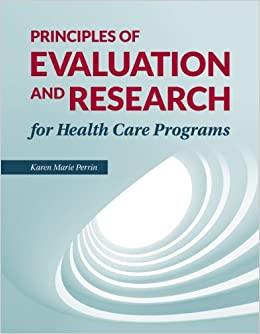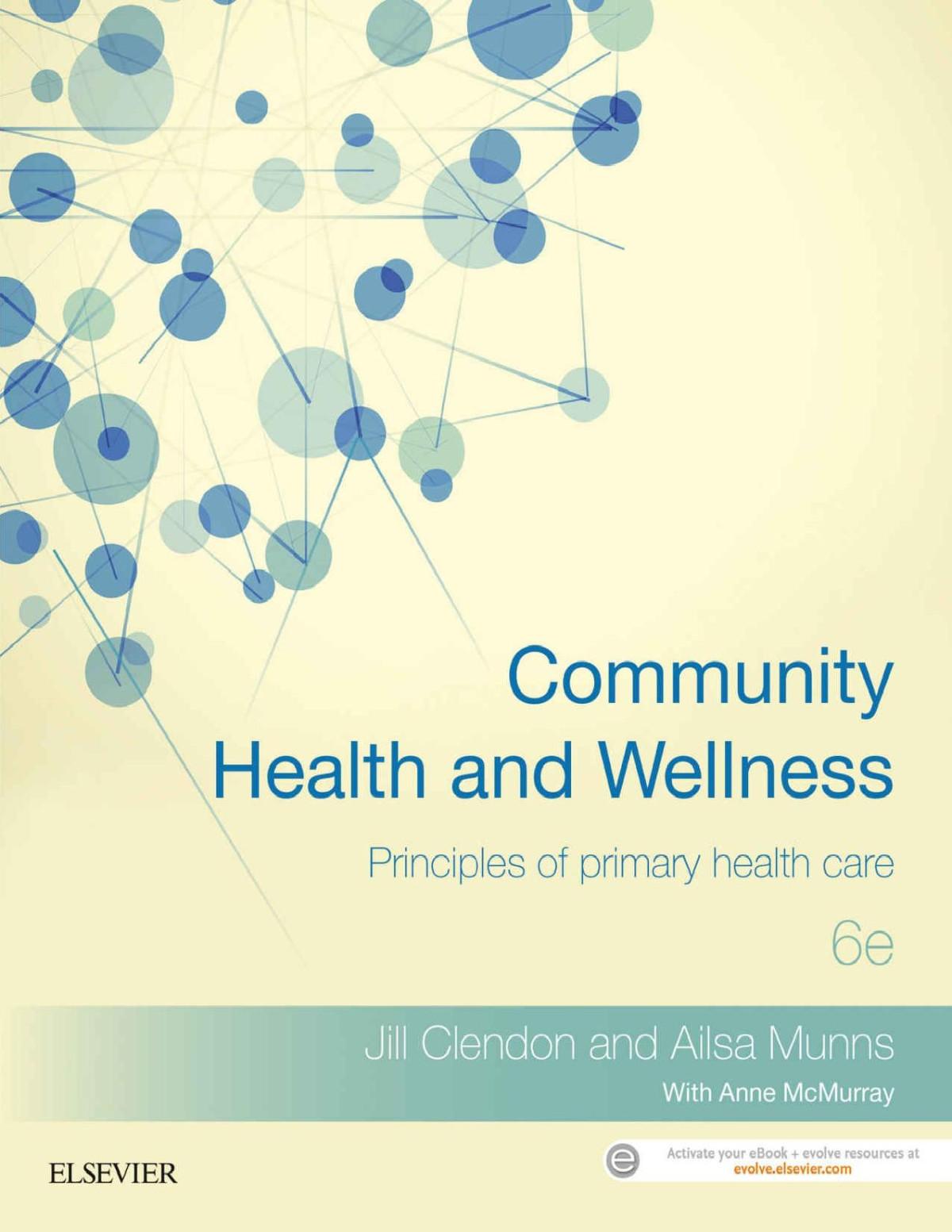
https://ebookmass.com/product/principles-of-research-andevaluation-for-health-care-programs/

Instant digital products (PDF, ePub, MOBI) ready for you
Download now and discover formats that fit your needs...
Community Health and Wellness Jill Clendon & Ailsa Munns [Clendon
https://ebookmass.com/product/community-health-and-wellness-jillclendon-ailsa-munns-clendon/
ebookmass.com
Program Evaluation for Social Workers: Foundations of Evidence-Based Programs Richard M. Grinnell Jr
https://ebookmass.com/product/program-evaluation-for-social-workersfoundations-of-evidence-based-programs-richard-m-grinnell-jr/
ebookmass.com
Program Evaluation for Social Workers: Foundations of Evidence Based Programs 7th Edition, (Ebook PDF)
https://ebookmass.com/product/program-evaluation-for-social-workersfoundations-of-evidence-based-programs-7th-edition-ebook-pdf/
ebookmass.com
(eBook PDF) Becoming an Active Reader 3rd Edition



https://ebookmass.com/product/ebook-pdf-becoming-an-active-reader-3rdedition/
ebookmass.com

At Face Value, Second Edition: The Life and Times of Eliza McCormack/John White Don Akenson
https://ebookmass.com/product/at-face-value-second-edition-the-lifeand-times-of-eliza-mccormack-john-white-don-akenson/
ebookmass.com
The Slightly Greener Method: Detoxifying Your Home Is Easier, Faster, and Less Expensive than You Think 1st
Edition Tonya Harris
https://ebookmass.com/product/the-slightly-greener-method-detoxifyingyour-home-is-easier-faster-and-less-expensive-than-you-think-1stedition-tonya-harris/
ebookmass.com
Replacing the Dead: The Politics of Reproduction in the Postwar Soviet Union Mie Nakachi
https://ebookmass.com/product/replacing-the-dead-the-politics-ofreproduction-in-the-postwar-soviet-union-mie-nakachi/
ebookmass.com
Jews in the Garden: A Holocaust Survivor, the Fate of His Family, and the Secret History of Poland in World War II
Judy Rakowsky
https://ebookmass.com/product/jews-in-the-garden-a-holocaust-survivorthe-fate-of-his-family-and-the-secret-history-of-poland-in-world-warii-judy-rakowsky/ ebookmass.com
Lippincott Illustrated Reviews Flash Cards: Biochemistry (Lippincott Illustrated Reviews Series) 1st Edition, (Ebook PDF)
https://ebookmass.com/product/lippincott-illustrated-reviews-flashcards-biochemistry-lippincott-illustrated-reviews-series-1st-editionebook-pdf/
ebookmass.com





The Prophet Of Modern Constitutional Liberalism: John
Stuart Mill And The Supreme Court 1st Edition Edition John Lawrence Hill
https://ebookmass.com/product/the-prophet-of-modern-constitutionalliberalism-john-stuart-mill-and-the-supreme-court-1st-edition-editionjohn-lawrence-hill/ ebookmass.com


Contents
Preface
Acknowledgments
Chapter 1 Purpose
Chapter Objectives
Key Terms
Introduction
Difference Between Research and Evaluation
Purpose of Evaluation
Needs Assessment
Literature Review
Books
Government Documents
Non-Governmental Organization (NGO) Documents
Newspapers
Magazines
Theses and Dissertations
Development of Research Questions or Goal Statements
Evaluation: Goals and Objectives
Evaluation: Role of Stakeholders
Evaluation: Implementation
Types of Evaluations
Formative Evaluation
Summative Evaluation
Process Evaluation
Outcome Evaluation
Impact Evaluation
Evaluation: Logic Models
Summary
Case Study: Healthy Food/Healthy People
Goal Statement
Objectives
Case Study Discussion Questions
Student Activities
References
Chapter 2 Ethics
Chapter Objectives
Key Terms
Introduction
Historical Background
U.S. Public Health Service Syphilis Study in Tuskegee Henrietta Lacks
Basic Principles of Medical Ethics
Ethical Links Between Research and Evaluation
Confidentiality of Medical Information and Research Data
Healthcare Providers: Medical Care Versus Medical Research
Physical Therapy Example
Nursing Example
Medical Example
Hospital Administration Example
Hospital Ethics Committee Example
Evaluation Example
Institutional Review Board
Informed Consent
Risk/Benefit Assessment
Selection of Individuals and Special Populations
Summary
Case Study: Diaz vs. Hillsbourgh County Hospital Authority
An Inquiry
The Next Step
The Lawsuit
Doctors’ Perspective
The Settlement
A Postscript
Case Study Discussion Questions
Student Activity References
Chapter 3 Determinants of Health
Chapter Objectives
Key Terms
Introduction
Historical View of Achievement in Health
Health Disparities
Social Determinants of Health
Physical Activity
Education
Access to Health Care
Resources: Safe Food, Safe Housing, and Employment
Using Healthy People 2020 to Study Health Disparities and
Social Determinants of Health
Summary
Case Study
Case Study Discussion Questions
Student Activity
Census FactFinder Treasure Hunt
References
Answers to Questions Pertaining to Table 3-2
Chapter 4 Theories and Models
Chapter Objectives
Key Terms
Introduction
Deductive and Inductive Reasoning
Types of Theories and Models
Universal Theories
System Theories
Community and Organizational Theories and Models
Individual Behavior Theories and Models
Strategic Planning Models
Gantt Charts
Action Plans
SWOT Analysis
Summary
Case Study
Case Study Discussion Questions
Student Activities
References
Chapter 5 Reliability and Validity
Chapter Objectives
Key Terms
Introduction
Reliability
Stability
Internal Consistency
Validity
Types of Validity
Internal Validity
Threats to Internal Validity
External Validity
Threats to External Validity
Relationship Between Internal and External Validity
Measurement Errors
Random Errors
Systematic Errors
Reliable and Valid Research
Randomized Controlled Trial Designs
Adequate Sample Size
Free of Bias
Pilot Testing
Sample of Respondents
Data Collection for Pilot Tests
Data Analysis Outcome
Summary
Case Study
Step 1: Review Existing Survey Data
Step 2: Reliability of Existing Survey
Step 3: Validity of Existing Survey
Step 4: Creating a New Survey
Step 5: Pilot Testing
Step 6: One Year Later
Case Study Discussion Questions
Student Activity Questions
Answers
References
Chapter 6 Qualitative Data
Chapter Objectives
Key Terms
Introduction
The Qualitative-Quantitative Debate
Qualitative Methods: Validity and Reliability
Types of Qualitative Design
Interviews
Observations
Case Studies
Phenomenology
Historical Documents
Content Analysis
Ethnography
Grounded Theory
Ethical Issues in Qualitative Research
Analyses of Qualitative Data
Data Organization
Coding Data
Data Display
Summary
Case Study
Summary
Case Study Discussion Questions
Student Activity
Case Study 1
Case Study 2
Case Study 3
Case Study 4
References
Chapter 7 Elements of Research
Chapter Objectives
Key Terms
Introduction
Elements of Research
Basic and Applied Research
Variables
Observations or Measurements
Treatments or Programs
Group Assignment
Constructs
Operational Definitions
Types of Research Design
True Experimental Design
Quasi-Experimental Design
Nonexperimental Design
Summary
Case Study
Research Question
Operational Definitions
Recruitment
Study Design
Random Group Assignment
Data Collection
Case Study Discussion Questions
Student Activity
Case Study 1
Case Study 2
Case Study 3
Case Study 4
References
Chapter 8 Surveys
Chapter Objectives
Key Terms
Introduction
Survey Selection
Creating a Survey
Survey Data Collection
Types of Surveys
Tests
Personality Inventories
Scales
Cultural and Diversity Influences in Data Collection
Survey: Reliability and Validity
Summary
Case Study
Research Questions
Operational Definitions
Data Collection Training
Data Collection
Data Entry
Data Analysis
Case Study Discussion Questions
Student Activity
Questions
Answers
References
Chapter 9 Data Tools
Chapter Objectives
Key Terms
Introduction
Data Classification
Categorical Data
Continuous Data
Data Organization
Descriptive Data
Graphic Presentation
Measures of Central Tendency
Mean
Median Mode
Normal Curve
Standard Deviation and Variance
Summary
Case Study
Survey Questions
Case Study Discussion Questions
Student Activity
Answers
References
Chapter 10 Populations and Samples
Chapter Objectives
Key Terms
Introduction
Populations and Samples
Probability and Inferential Statistics
Research and Null Hypothesis
Level of Significance
Sample Size Considerations
Margin of Error
Population, Sample, and Variability
Confidence Level
Budget and Budget Justification
Timeline
Probability and Nonprobability Samples
Probability Sampling
Nonprobability Sampling
Sampling Bias
Item Nonresponse Bias
Unit Nonresponse Bias
Summary
Case Study
Case Study Discussion Questions
Student Activity
Answers
References
Chapter 11 Inferential Statistics
Chapter Objectives
Key Terms
Introduction
Types of Statistics
The Need for Statistics
Inferential Statistics
Scientific Hypothesis
Research Questions
Null Hypothesis and Alternate Hypothesis
Basic Inferential Statistical Tests
One-Tailed and Two-Tailed Statistical Tests
Using Excel for Statistics
Chi-Square Test
t-Tests
Correlation Coefficients
Confidence Intervals
Type I and Type II Errors
Summary
Case Study
Case Study Discussion Questions
Answers
Student Activities
Answers
References
Chapter 12 Budgets and Cost Analyses
Chapter Objectives
Key Terms
Introduction
Budgets
Personal Budgets
Evaluation and Research Project Budgets
Budget Summaries: Profit and Loss Statements
Cost Analysis
Cost-Benefit Analysis
Cost-Effectiveness Analysis
Cost-Utility Analysis
Cost-Feasibility Analysis
Summary
Case Study
Case Study Discussion Questions
Student Activity
Answers
References
Chapter 13 Reports and Presentations
Chapter Objectives
Key Terms
Introduction
Types of Written Reports
Elements of the Report
Title Page
Table of Contents
Abstract or Executive Summary
Introduction
Literature Review or Background
Methods
Results
Discussion, Conclusion, Recommendations, and Future Research
References and Appendices
Presentation of Results
Oral Presentations
Poster Presentations
Tips for Successful Presentations
Summary
Case Study
Case Study Discussion Questions
Student Activities References
Chapter 14 Case Study: University Medical Cancer Care Center
Description
Overview of Evaluation
Budget
Budget Justification
Personnel
Graduate Students
Consultants
Focus Groups
Travel
Indirect Costs
Evaluation
Clinical Staff and Clinical Support Staff
Laboratory
Nonclinical Staff
Central Supply, Technical Support, Physical Plant and Environmental Services (CTPES)
Finance and Accounting
Board of Directors, Executive Administration, and Management
Patient Satisfaction
Draft of the Final Report
Evaluation of Clinical Staff and Clinical Support Staff
Evaluation of Laboratory
Evaluation of Nonclinical Staff
Evaluation of CTPES Staff
Evaluation of Finance and Accounting
Evaluation of Board of Directors, Executive Administration, and Management
Evaluation of Patient and Visitor Satisfaction
Recommendations for the Final Report
Student Activity
Preface
This text was written for undergraduate students enrolled in an introductory course related to research or evaluation. The chapters are in a sequential order that forms the foundation for the knowledge needed to understand basic evaluation or research projects. This text is not intended to achieve complete understanding or proficiency in the complex subjects of health science evaluation and research. However, the chapters provide an overview of topics needed to review published literature, collect primary data, analyze data using basic statistics, and present results in written or verbal formats for their intended audiences.
The first three chapters set the stage for evaluation and research. Chapter 1 explains the differences and similarities between evaluation and research, along with how to review literature and develop research questions or goals and objectives that will be addressed in various studies. Chapter 2 introduces ethics, which is a core element in evaluation and research and needs consideration during the development phase. Chapter 3 explores determinants of health, such as health disparities and access to health care. Without regard to social determinants, evaluators and researchers miss key elements in the lives of their target audience that influence health outcomes outside of health care.
The next several chapters define terms and concepts that should be understood prior to planning an evaluation and research study. Chapter 4 introduces various types of theories and models along with examples from
current literature on how the theories and models have been used as the framework for project development. The list of theories and models is not intended to be comprehensive, but rather an introduction to examples that are commonly used. Once the research questions or evaluation goals and objectives and an appropriate theory are selected, it is time to explore types of data. Chapter 5 defines the concepts of reliability and validity as well as random and systematic errors. The chapter ends with a detailed description of how to conduct a pilot test and why they are essential. Chapter 6 provides a detailed discussion of qualitative data including types qualitative designs, potential ethical issues, and analyses utilized in qualitative data. Chapter 7 presents some basic elements of research including the difference between basic and applied research, variables, group assignment, constructs, and operational definitions. After these concepts are understood, the three basic types of research design (true experimental, quasi-experimental, and nonexperimental) are defined and examples are provided to enhance understanding. Chapter 8 focuses on survey design, including types of surveys and how to select them. Various tests, inventories, and scales are introduced along with examples and reasons for selecting one survey type over another. A discussion of how culture and diversity influences data collection is included near the end of the chapter.
Chapters 9, 10, and 11 focus on basic skills related to data. Chapter 9 introduces how data are classified as categorical or continuous and then organized using frequency distributions. Building on this knowledge, the concepts of measures of central tendency, the normal curve, standard deviation, and variance are explained in detail with plenty of examples. This chapter serves as the foundation for understanding the next two chapters. Chapter 10 describes terms related to population and samples. There are three main topics covered: sample size considerations, probability and nonprobability samples, and sampling bias. Each topic deserves important consideration when determining the sample size needed for any evaluation or research project. Chapter 11 introduces inferential statistics and defines the terms scientific hypothesis, research questions, null hypothesis, and alternative hypothesis. The next section presents basic statistical tests (e.g., chi-square, t-tests, and correlation coefficients). The chapter ends with a discussion of type I and type II errors.
The last chapters provide skills related to budgets, reports, and presentations, and the text culminates with a case study. Chapter 12 is divided into two sections. The first section describes various types of budgets with examples to practice basic skills. Budget justifications are also presented. The second section defines the types of cost analyses and how each type is used. Chapter 13 illustrates several ways to present results including abstracts, executive summaries, reports, manuscripts, posters, and verbal presentations. Chapter 14 is a lengthy case study reinforcing all aspects presented in this book.
